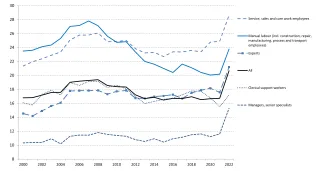Finnish Institute of Occupational Health media release 22 May 2023
In 2022, sickness absences increased regardless of occupation, gender or age group, although the first years of the pandemic, 2020 and 2021, did not yet result in increased sickness absences.
On average, municipal employees were absent from work for 20.7 days due to their own illness, which is four days more than in the previous year.
The Kunta10 study of the Finnish Institute of Occupational Health has monitored employees' sickness absences since 2000. The statistics are based on employers' register data. The statistics in the Kunta10 study cover all absences due to the employees’ own illness from the first day of absence, but do not include information on the reasons for sickness absences.
“It is likely that the increase observed now can be explained by absences caused by COVID-19,” says Senior Researcher Jenni Ervasti from the Finnish Institute of Occupational Health.
This can be deduced from Kela's sickness allowance statistics, which provide information on long absences of more than 9 days and the reasons for them.
“Absences due to COVID-19 increased in Kela's statistics in 2022. However, sickness allowances granted on the basis of mental health disorders, musculoskeletal diseases and respiratory diseases remained at the previous year's level,” says Jenni Ervasti.
The largest number of absences occurred in health care professions

Health care professions are still among the top in terms of average sickness absences: early childhood educators, family day care providers, ward domestics, practical nurses, child care providers, school assistants and home care workers were, on average, absent from work for more than 25 days due to their own illness in 2022.
The lowest rates of absences due to one's own illness were among managers, senior specialists, finance secretaries and publicists (9–11 days on average).
In relative terms, park workers, housekeepers, firefighters, security guards, managers in education, ward domestics, child care providers and early childhood education teachers had the highest increase in sickness absence days compared to the previous year.
Employees aged under 30 were absent the most, but the differences between age groups have not increased from last year.
In 2022, all employee groups have been ill
In 2022, the proportion of those who were absent for zero days decreased in all occupations in the municipal sector. In previous years, switching to remote work and avoiding contacts had increased the proportion of employees who were not absent for a single day during the year due to their own illness.
The proportion of employees who were sick for zero days was 29% in 2021 and only 16% in 2022.
“Last year, being absent for at least one day due to sickness was most common in jobs with a lot of personal contacts, such as health care, social work, early childhood education, education and rescue services. This, too, supports the assumption that COVID-19 is the underlying cause of absences,” Ervasti says.
Sickness absences in all occupational groups have increased.
“Compared to the previous year, the proportion of those who were absent for zero days decreased the most in management positions, although there are still more people in this group who were absent for zero days than in many other positions,” Ervasti continues.
Learn more
- Updated information on sickness absences in the municipal sector can be found in the Finnish Institute of Occupational Health's Work-Life Knowledge service at: Sickness absence in Finnish municipalities | Work-life knowledge service | www.worklifedata.fi (tyoelamatieto.fi)
- The data is available in Finnish, Swedish and English.
- Kela’s sickness allowance statistics 2022 (in Finnish): Sairauspäivärahat jatkavat kasvu-uralla – vuonna 2022 koronavirus näkyi aiempaa selvemmin sairauspäivärahaa saaneiden määrässä | Kela Info Tray (available in Finnish only)
The Kunta10 study
- The Finnish Institute of Occupational Health’s Kunta10 study is the most extensive nationwide follow-up study in the Finnish municipal sector.
- The Kunta10 study involves Helsinki, Espoo, Vantaa, Tampere, Turku, Oulu, Naantali, Raisio, Nokia, Valkeakoski and Virrat.
- The annual sickness absences of more than 90,000 municipal employees is monitored from the personnel registers of employers in a uniform manner in proportion to the actual sickness absence days and the number of person-years worked.
- These statistics do not include the causes of sickness absences.
- One municipality's statistics in 2021 and another municipality's statistics in 2022 had to be excluded from the total results.
Further information
- Jenni Ervasti, Senior Researcher, PhD, Adjunct Professor, jenni.ervasti [at] ttl.fi (jenni[dot]ervasti[at]ttl[dot]fi), +358 (0)30 474 2806





